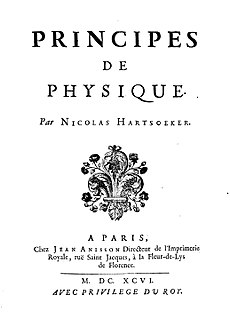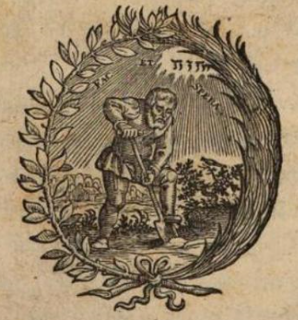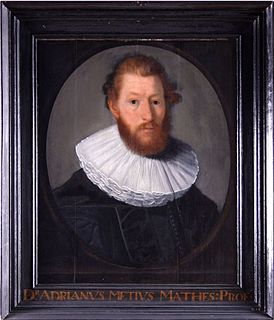 W
WAdriaan Anthonisz (1527–1607) was a Dutch mathematician, surveyor, cartographer, and military engineer who specialized in the design of fortifications. As a mathematician Anthonisz discovered in 1585 the ratio of a circle's circumference to its diameter, which would later be called pi.
 W
WLudolph van Ceulen was a German-Dutch mathematician from Hildesheim. He emigrated to the Netherlands.
 W
WJohan Jacob Ferguson was a Dutch mathematician who corresponded with Gottfried Wilhelm Leibniz.
 W
WJacob Golius born Jacob van Gool was an Orientalist and mathematician based at the University of Leiden in Netherlands. He is primarily remembered as an Orientalist. He published Arabic texts in Arabic at Leiden, and did Arabic-to-Latin translations. His best-known work is an Arabic-to-Latin dictionary, Lexicon Arabico-Latinum (1653), which he sourced for the most part from the Sihah dictionary of Al-Jauhari and the Qamous dictionary of Fairuzabadi.
 W
WNicolaas Hartsoeker was a Dutch mathematician and physicist who invented the screw-barrel simple microscope circa 1694.
 W
WMartin (Maarten) van den Hove was a Dutch astronomer and mathematician. His adopted Latin name is a translation of the Dutch hof ("garden"), in Latin horta.
 W
WJohannes Hudde was a burgomaster (mayor) of Amsterdam between 1672 – 1703, a mathematician and governor of the Dutch East India Company.
 W
WChristiaan Huygens, also spelled Huyghens, was a Dutch physicist, mathematician, astronomer and inventor, who is widely regarded as one of the greatest scientists of all time and a major figure in the scientific revolution. In physics, Huygens made groundbreaking contributions in optics and mechanics, while as an astronomer he is chiefly known for his studies of the rings of Saturn and the discovery of its moon Titan. As an inventor, he improved the design of the telescope with the invention of the Huygenian eyepiece. His most famous invention, however, was the pendulum clock in 1656, which was a breakthrough in timekeeping and became the most accurate timekeeper for almost 300 years. Huygens was an outstanding mathematician and, because he was the first scientist of the modern era to transfer mathematical inquiry to describe unobservable physical phenomena, he has been called the first theoretical physicist and the founder of modern mathematical physics.
 W
WAdriaan Adriaanszoon, called Metius,, was a Dutch geometer and astronomer born in Alkmaar. The name "Metius" comes from the Dutch word meten ("measuring"), and therefore means something like "measurer" or "surveyor."
 W
WBernard Nieuwentijt, Nieuwentijdt, or Nieuwentyt was a Dutch philosopher, mathematician, physician, magistrate, mayor, and theologian.
 W
WFranciscus van Schooten was a Dutch mathematician who is most known for popularizing the analytic geometry of René Descartes.
 W
WRudolph Snel van Royen, Latinized as Rudolph Snellius, was a Dutch linguist and mathematician who held appointments at the University of Marburg and the University of Leiden. Snellius was an influence on some of the leading political and intellectual forces of the Dutch Golden Age.
 W
WWillebrord Snellius was a Dutch astronomer and mathematician, known in the English-speaking world as Snell. In the west, especially the English speaking countries, his name is attached to the law of refraction of light.
 W
WSimon Stevin, sometimes called Stevinus, was a Flemish mathematician, physicist and military engineer. He made various contributions in many areas of science and engineering, both theoretical and practical. He also translated various mathematical terms into Dutch, making it one of the few European languages in which the word for mathematics, wiskunde, was not a loanword from Greek but a calque via Latin. He also replaced the word chemie, the Dutch for chemistry, by scheikunde, made in analogy with wiskunde.
 W
WJohannes or Johan Teyler was a Dutch Golden Age painter, engraver, mathematics teacher, and promoter of the technique in color printmaking now known as à la poupée.
 W
WAdriaan Vlacq (1600–1667) was a Dutch book publisher and author of mathematical tables. Born in Gouda, Vlacq published a table of logarithms from 1 to 100,000 to 10 decimal places in 1628 in his Arithmetica logarithmica. This table extended Henry Briggs' original tables which only covered the values 1-20,000 and 90,001 to 100,000. The new table was computed by Ezechiel de Decker and Vlacq who calculated and added 70,000 further values to complete the tables. This table was further extended by Jurij Vega in 1794, and by Alexander John Thompson in 1952.
 W
WJohan de Witt was a Dutch statesman and a major political figure in the Dutch Republic in the mid-17th century, when its flourishing sea trade in a period of globalization made the republic a leading European trading and seafaring power – now commonly referred to as the Dutch Golden Age. De Witt controlled the Dutch political system from around 1650 until shortly before his death in 1672, working with various factions from nearly all the major cities, especially his hometown, Dordrecht, and the hometown of his wife, Amsterdam.